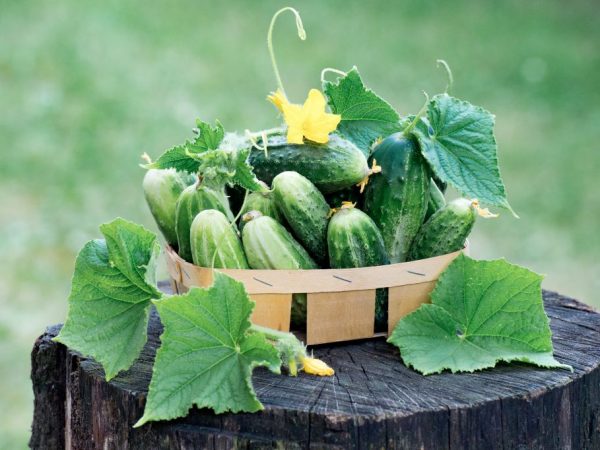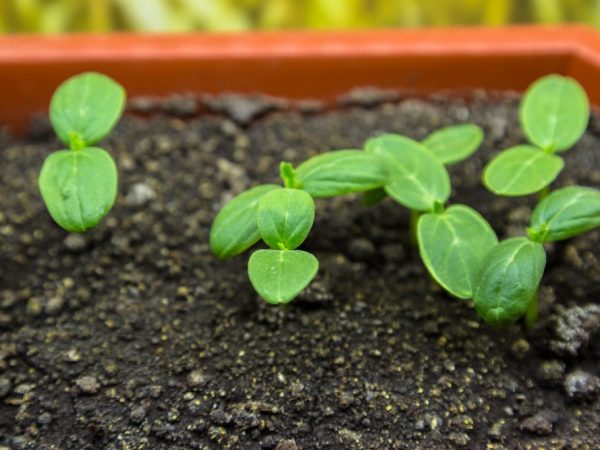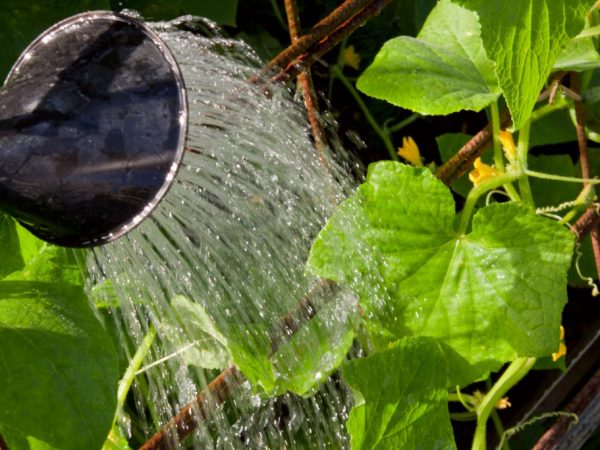Galina Kizima's advice on growing cucumbers
Kizima's advice on growing cucumbers for amateur gardeners can be used as a guide to action. They are simple and affordable, and therefore it is not at all difficult to follow them, and the effect will surpass all expectations.
- The essence of the Kizima method
- Preparing the soil for seedlings
- Planting cucumbers in a cascade way
- Prerequisites for the cascade method
- Replacement of watering and feeding
- Care during growth
- Benefits of planting in the ground
- Planting cucumbers in greenhouses
- Soil preparation
- Moistening the soil
- Temperature
- Heating the seeds before planting
- Hydrogel planting method
- Tips for growing cucumbers in the northern regions
- Forming cucumbers
- Conclusion

Galina Kizima's advice on growing cucumbers
The essence of the Kizima method
Before planting any vegetables, you need to properly prepare the soil. Kizima believes that there is no need to interfere with nature. She herself creates all the conditions for excellent growth.
As a result of this approach, Galina developed a special land use system without much difficulty. She removed the most laborious jobs:
- digging;
- weeding;
- watering.
All this is done by nature itself. The root system of plants, according to Kizima, requires fresh humus. It is obtained as a result of rotting of last year's plant debris. Rotten compost and humus are a strategic fertilizer reserve. It will give new strength, new opportunities for growing strong green mass. This is the cycle of organic matter in nature, which must not be disturbed.
Nature does not allow empty, bare soil so as not to collapse from the sun and wind. Genuine fertility is created by the huge number of microorganisms that live in the earth. All green mass should be raked under the plants. Never throw away or incinerate anything.
The only thing that can be done is to process plant residues with biological products from autumn. There will be no pathogens on them and under them. In late autumn, plant stems will fall and cover the ground. This will also retain moisture after the snow melts.
Preparing the soil for seedlings
For growing seedlings at home, Kizima does not advise buying soil. She herself brings her from the dacha. Its land is tested and will never be infected with pathogenic microflora and pest larvae. If this is not possible, then it is better to warm up the purchased soil. Place it in a sealed bag in a bucket of hot water. Cover and leave to cool completely.
Better to make the ground from a mixture of coconut substrate and sand. You can replace the coconut substrate with high-moor peat. But in this case, a liter can of ash or half a liter of dolomite should be added to 1 bucket of substrate.
Store mixes have their own advantages and disadvantages. They are sterile, there are definitely no pathogens in them - and this is their undoubted plus. But at the same time, such mixtures are completely empty - and this is their minus. Therefore, feeding begins immediately after the appearance of the first loop shoots. Top dressing is applied along with watering. Kizima advises fertilizing with Uniflor-bud or Unifrol-growth. It is a chelated fertilizer containing a full complement of trace elements. Plants can use such a top dressing immediately.

The soil must be prepared before planting.
The self-defense ability of the sprouts is very important. Biopreparations Zircon, Epin-extra, Zdorovy Sad, Ekoberin and Novosil help its development. By spraying every week with their solutions, you can avoid almost all diseases.
Planting cucumbers in a cascade way
The choice of landing in a cascade way is not accidental. The greenhouse is located in a southerly direction. This provides the following benefits:
- good lighting;
- maximum warmth;
- saving planting space
- ease of service;
- reduction in seed material consumption.
Each grower chooses the size of the cascade himself, depending on the amount of volumes.
Prerequisites for the cascade method
Before planting, the soil is spilled with a solution of phytosporim or a weak solution of potassium permanganate. This will destroy any remaining infection or bacteria.
For sowing in the ground, Kizima advises alternating hybrids with varieties of cucumbers. This contributes to better pollination. Galina Aleksandrovna advises covering each hole with a plastic 5 liter bottle with a cut-off bottom immediately after sowing. Spud a little earth.
Seedlings will be protected from slugs that eat cotyledon leaves. Every vegetable grower faced a problem when no shoots emerged after planting. Having dug up the ground, you can see the opened seed, but without a sprout. This earth pest, padura, eats the insides of the seeds.
The bottles protect crops from possible frost. Especially if the sowing is done early. Plants develop inside as long as there is enough space for them.
Replacement of watering and feeding
To facilitate watering and feeding, Kizima advises using dark 2 liter bottles. They are inserted without a cork, with a neck into the ground, from the south, between bottles with plants. A weak nutrient solution is poured into them. An earthen plug is formed. Therefore, the solution will go into the ground very slowly.
This liquid is enough for a long time. The plant receives both moisture and nutrition. The soil does not dry out. Periodically, the liquid in the bottles needs to be replenished.
According to Kizima, the tip of the plant has a scent. The tip of the root knows where the food is and where the water is and is drawn to this place. In autumn, when harvesting, you can see that all the roots are located exactly near these dark bottles.
Dark bottles are also needed to maintain the temperature in the soil. They heat up well during the day, even if there is no clear sun. And then they transfer this heat to the soil. The seedlings grow well, become green and vigorous.
Care during growth

Long lashes need to be pinched
After these events, the cascade is covered with a film that can be secured with clothespins. When the plants grow large, the film is replaced with double lutrasil. In hot weather, the film is removed, and the lutrasil can not be touched. Unlike polyethylene, it breathes. The bottles are also removed by this time.
As soon as the lashes become too long and hang down to the next stage of the cascade, they are pinched. New roots grow in this place. At each step, the process is repeated as the plants grow. As a result, additional roots are formed 3-4 times along the length of the stem. This is the focus of cascading cucumber sowing. A huge harvest is obtained from a small number of seeds.
Benefits of planting in the ground
You can plant in a greenhouse in two ways: seedling and non-seedling. There is no particular sense in growing cucumbers through seedlings at home. Only 7-10 days are won.
This is because the sucking hairs break off at the slightest loosening of the soil and no longer recover. Transplant for pumpkin seeds is a big stress. Some of the leaves die, the plant loses its strength. Development slows down by about 10 days. Seeds sown in the ground manage to sprout during this time. They will be much stronger and stronger than the transplanted ones. They will immediately be able to move into growth.
Planting cucumbers in greenhouses
Transplant seedlings should be at the age of 25 days. At this time, one true leaf has already been formed, and the root system is just beginning to form. She will not be as prone to the stress of the transplant.Better yet, plant with cotyledon leaves.
It is good to plant dry seeds directly in the greenhouse. Usually 2-3 seeds at an equal distance from each other, edge-to-edge into the soil. Cover immediately.
Sowing is usually done in early May. It grows well on insulated soil. The soil is insulated either with a feather, or simply spilled with hot water just before planting.
After 7 days, the first shoots appear. The film must be removed so that they do not burn out under the rays of the sun. If covered with lutrasil, then it can be left. With such a shelter, cucumbers in a greenhouse will withstand frosts down to minus 5 ° C -6 ° C.
When true 1-2 sheets appear, you need to carefully plant excess plants from each nest. Dutch seeds are famous for not very good germination, according to Galina's observations. She most often uses the Bejo company. If there are fears that slugs may start, then play it safe and cover the holes with bottles.
Soil preparation
Before planting, you need to dig trenches. Depth and width per shovel bayonet. Add dry hay to them, not rotted compost or foliage. Put the earth taken out of the trench on top and walk on it for compaction. Water this soil and cover with an opaque plastic wrap. After 7 days, the soil will warm up because the hay will start to rot and generate heat. Cucumbers can be sown.
Moistening the soil

Cucumbers need regular watering
Cucumbers are a moisture-loving vegetable crop. But there should be no excessive watering. Drip irrigation can help avoid this. Hoses with holes or ordinary plastic bottles can be used for this. 1 bottle is enough for four plants.
Temperature
These vegetables do not like cold snaps at night. If the greenhouse is high, the air may cool too much and the heat from the soil will not be sufficient. Therefore, you need to use any devices for heating. For example: kerosene lamps, band heaters, electric heaters, etc.
Heating the seeds before planting
Not all seeds require preheating. If the planting is from hybrids, then you do not need to warm up. The packages are marked with F1. They have a predominantly female color type.
In the case of planting common varieties, especially if the seeds are fresh, it is better to warm them up. This stimulates the rapid emergence of female flowers. The fact is that male inflorescences do not give cucumbers.
A month before sowing, a bag of seeds is suspended from a radiator with central heating or, just before planting, it is heated in hot water (53 ° C) for 15-20 minutes. In addition to warming up, this will also free the seeds from pathogens of various diseases. Recently, varieties are more often used by hybrids.
Hydrogel planting method
A hydrogel for growing cucumbers in a greenhouse is a polymer crumb that, when interacting with water, increases 300 times. Retains moisture and, if necessary, sucks it from the roots.
When planting cucumber seedlings, the hydrogel must be poured directly into the hole. About half a glass. Sprinkle 4-5 cm of soil on top and then sow the seeds. You can prepare a hydrogel solution in advance. To do this, you need to dilute 10 g of the substance in 3 liters of water. When planting, add half a glass of gel under each plant.
The seeds should not be dipped directly into the hydrogel. This is the same as being immersed in water. They can simply rot or suffocate without air. The hydrogel dissolved can be dissolved in a solution of organic or mineral fertilizers. In this case, you can get rid of the laborious feeding process.
Galina Aleksandrovna advises using Fitosporin or Gumi as food. For organic feeding - fertilizer (OMU) or a powder fraction of the unique AVA fertilizer.
Tips for growing cucumbers in the northern regions
Methods and methods depend on the growing region. In colder climates, it is better to use trellises in low greenhouses. The horizontal position is suitable for small greenhouses. Warm air from the ground will only linger on a small volume.
In the northern regions, it should be grown in a covering way, covered at night and opened during the day. It is more convenient to do this if arcs are installed above the ridge. They can be made from metal or from willow rods without bark. Such natural arcs will last 5-6 years.
After frost, tie it up (if growing on a vertical trellis). To do this, tie a lace under the first real sheet and circle it under each sheet with a loop. Pull the cord and tie it to the horizontal wire. Above the ground up to 1.5 m. After the cucumber vine reaches the wire, it just needs to be thrown over. They will grow downward after tying the growing end of the stem to the part below.
Forming cucumbers
In a horizontal position, shaping is not required. In the vertical, formation is reduced to plucking a sheet of viscera from the bosom. Thus, 3-4 lower sheets are blinded. This must be done so that the lower lashes do not grow. Which take up a lot of nutrients and do not produce fruit at the same time. They do not have enough light for this .. They also thicken the bushes. Poorly ventilated and rot.
Conclusion
Applying tips on growing cucumbers from the famous gardener Galina Kizima, you can get a high-quality and generous harvest with a minimum of effort. It is important to remember that each method is good in its own way and it is better to try all methods on different varieties of vegetables.


